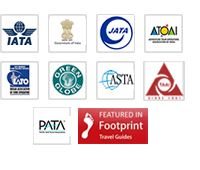12 Days from USD 2000 onwards
From the days when the Job Charnock dropped his anchor at Cossim Bazar to the days when the Nawab of Murshidabad made the city as the capital in 1716 AD, Experience the Bengal in its full granduer and valour.
Cruise down the memory lane, Experience Bengal's history, heritage and culture, Renaissances of the Bengal philosophy uprise of the freedom struggle, to the evolution of what Bengal is.
- Kolkata, the city
- European reminiscences
- Terracotta architecture - Palace and temples
- Weaving village at Shantipur
- Traditional Kansari artisans at Matiari
- History at Murshidabad
- The longest river barrage with 108 gates
C02-UP C05-DOWN
UP ITINERARY
Embarkation: Gadkhali Jetty, Sunderbans Upstream : Embarkartion - Kolkata;
Disembarkartion - Farakka.
Day 1
Check in at Vivada jetty, Millennium park as per convienence. Depending upon the tide the cruiser sails past the Howrah Bridge late evening or early morning next day.
Day 2
The Europe on Ganges : There are 5 European reminiscence within 40 km north of Kolkata and were trading post. The vessel will drop anchor at these places as per the guest choice. Visit any two or more. Barrackpore, the British Governors residence, Serampore : the Danish Colony under the name Frederiksnagore from 1755 to 1845 Chandannagore -the French colony from 1673 to 1952, except between 1757 to 1794 when it was under the British. Chinsura - "The Dutch had followed the Portuguese and Spanish to set up trading posts in India in 1615. They had stayed on till 1825, after which the British took over. Bandel - meaning the Port in Bengali, the place appears to the port during the time of Portuguese.
Day 3
Terracotta Temple with cycle rickshaw rides and Weavers village. Kalna - Maharajas of Bardhaman built several magnificent temples with intricate terracotta ornamentation, the main one being 108 Shiv Mandir built in 1809 in traditional AAT chala architecture and the Raj bari which house most of the temples. Shantipur / Fulia - the weavers of fine Bengal cotton, the village rich in handloom weaving, is the second largest occupation in the state of West Bengal. The weavers here blend the traditional art with the modern life style needs, offering rich variety of textiles. sarees, stoles, fabrics etc.
Day 4
Mayapur & Matiari Mayapur: Headquaters of ISKCON. Preaching the power of prayer to attain salvation. Matiari - Kansha ( Bell metal wares) was a poor man substitute to the rich silverware used in Bengali homes for prayers, table wares and also for cooking. The traditional Kansari artisans make from scrap metals and is handcrafted wares and artifacts.
Day 5
Murshidabad, the historic town, the earliest evidences of history perhaps as early as circa 1500 B.C. The Nawab Murshid Quli Khan made Murshidabad the capital city of Sube Bangla, comprising of Bengal, Bihar and Orissa. The East India Company reigned from here for many years after the Battle of Plassey; Visit Nizamat Kila, also known as the Hazaarduari Palace built by Duncan McLeod of the Bengal Engineers in 1867, in the Italianate style, Katra mosque & Katgola Gardens.
Day 6
Jangipur lock / Farakka Barrage the worlds longest Barrage, controlling the sharing of waters between India and Bangladesh.
Note: The time of excursions may vary depending upon the tidal and other environmental conditions.
DOWN ITINERARY
Embarkation: At Farakka. Disembarkation: At Kolkata.
Day 1
Check in Farakka jetty. Farakka Barrage the worlds longest Barrage, controlling the sharing of waters between India and Bangladesh.
Day 2
Murshidabad, the historic town, the earliest evidences of history perhaps as early as circa 1500 B.C. The Nawab Murshid Quli Khan made Murshidabad the capital city of Sube Bangla, comprising of Bengal, Bihar and Orissa. The East India Company reigned from here for many years after the Battle of Plassey; Visit Nizamat Kila, also known as the Hazaarduari Palace built by Duncan McLeod of the Bengal Engineers in 1867, in the Italianate style, Katra mosque & Katgola Gardens.
Day 3
Matiari & Mayapur Matiari - Kansha (Bell metal wares) was a poor man substitute to the rich silverware used in Bengali homes for prayers, table wares and also for cooking. The traditional Kansari artisans make from scrap metals handcrafted wares and artifacts. Mayapur: Headquaters of ISKCON. Preaching the power of prayer to attain salvation.
Day 4
Terracotta Temple with cycle rickshaw rides and Weavers village. Kalna - Maharajas of Bardhaman built several magnificent temples with intricate terracotta ornamentation, the main one being 108 Shiv Mandir built in 1809 in traditional AAT chala architecture and the Raj bari which house most of the temples. Shantipur / Fulia - the weavers of fine Bengal cotton, the village rich in handloom weaving is the second larget occupation in the state of West Bengal. The weavers here blend the traditional art with the modern life style needs, offering rich variety of textiles. sarees, stoles, fabrics etc.
Day 5
The Europe on Ganges : There are 5 European reminiscence within 40 km north of Kolkata and were trading post. The vessel will drop anchor at these places as per the guest choice. Visit any two or more. Bandel - meaning the Port in Bengali, Chinsura - "The Dutch had followed the Portuguese and Spanish to set up trading posts in India in 1615. They had stayed on till 1825, after which the British took over. the place appears to the port during the time of Portuguese. Chandannagore -the French colony from 1673 to 1952, except between 1757 to 1794 when it was under the British. Barrackpore the British Governors residence, Serampore : the Danish Colony under the name Frederiksnagore from 1755 to 1845
Depending upon the tide the cruiser sails past the Howrah Bridge late evening or early morning next day.
Day 6
Check out at Vivada jetty, Millennium park as per convenience.
Inclusions:
Accommodation + All meals at River Cruise + all sightseeing & transfers.
|
















